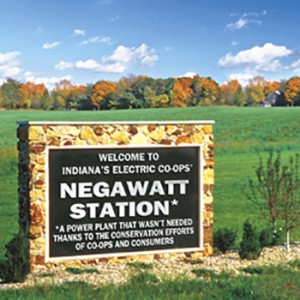
Here’s a sign you won’t actually see in rural Indiana. But Indiana’s co-ops and consumers have worked hard for a quarter century on energy conservation and efficiency to make the electricity we produce go farther. As energy demands continue to grow, new power plants will have to be built in the coming decade. But if we continue working together to save energy, we may not need as many new plants to meet estimated needs.
Benjamin Franklin’s old saying “a penny saved is a penny earned” is the sound wisdom behind “negawatts,” the notion that a megawatt saved is a megawatt unburned — a megawatt we don’t need to generate.
Coined back in the late 1980s, the term negawatts is once again gaining mainstream attention across the state and nation as America looks for ways to stave off the growing energy crunch and become less dependent on foreign energy sources. But energy conservation and efficiency are ideas Indiana’s electric cooperatives have embraced for more than a quarter century.
Energy conservation and efficiency is a cornerstone of Indiana’s new strategic energy plan, “Hoosier Homegrown Energy,” unveiled by Gov. Mitch Daniels and Lt. Gov. Becky Skillman last August. The plan outlines the need to use clean coal technology and renewables to meet our growing electricity needs. But it also promotes the need to increase energy efficiency and conservation.
“It’s a lot easier to save power than it is to produce it. We’ve just got to get serious to do it,” said John Clark, director of Indiana’s Office of Energy and Defense Development. “Every megawatt we save is a ‘negawatt’ — a megawatt we don’t need to produce. You’ve taken energy efficiency seriously,” Clark told Indiana’s electric co-op leaders at their annual meeting in December.
Power needs
Purdue University’s State Utility Forecasting Group predicts Indiana will need over 10,600 megawatts of additional electricity by 2023 to meet growing demand. That’s the equivalent of 15 new baseload power plants, the energy plan says. And building 15 new baseload plants in 15 years is not practical. “We must maximize our development of alternative energy and efficiency to achieve our future needs,” the plan states.
Clean coal technologies, which can use the abundant coal reserves in southwestern Indiana and meet clean air mandates, will likely be adopted in many of the new plants to be built. Renewables, like the continued tapping of landfill gas, coal methane and even wind turbines, are expected to also join the mix.
But the state’s energy plan also emphasizes that some of our future energy needs can be met by power sources already among us. That is the power of energy efficiency and conservation. In the past half dozen years, technology has improved the energy efficiency of most of our major home appliances and heating/cooling systems by leaps and bounds. And we all have the power within ourselves to conserve more energy — if we just change our wasteful ways.
The Alliance to Save Energy, a Washington, D.C.-based group promoting energy efficiency worldwide, says energy efficiency now contributes more than any single energy resource to meeting the country’s energy needs. “Energy efficiency,” the group notes, “is the quickest, cheapest and cleanest way to meet the anticipated growth in energy demand in the United States.”
The Alliance’s executive director Kateri Callahan told co-op leaders at their national gathering last year that Americans would be using 40 percent more energy each year if not for efficiency and conservation measures taken since 1973. “The good news is,” she added, “we ain’t done yet! The energy we waste today is our greatest energy resource for tomorrow.”
While new power plants will use new and developing technologies in the coming decades, the ageless words of wisdom from our mothers — “waste not, want not” — will continue to serve consumers and co-ops well. The benefits readily available from conservation and energy efficiency programs must not be overlooked by consumers and lawmakers seeking to cut traditional uses of fossil fuels, create a cleaner environment and lessen our nation’s dependence on foreign sources.
Watts from wasting not
Indiana’s electric cooperatives have long advocated energy conservation and efficiency among consumers.
Since at least the early 1970s, hardly a month has passed that the statewide electric cooperative publication, Electric Consumer, has not included articles and tips for consumers on how to save energy. Since at least the 1980s, Indiana’s REMCs and RECs have given consumers incentives to install high-efficiency electric water heaters and air conditioning/heating systems.
Also beginning in the early 1980s, many of the state’s REMCs have been active in promoting the concept of “demand-side management.” These are specific programs engineered to cut electric use at critical high-demand times through the cooperation of both co-op residential and commercial consumers. They reduce the need for cooperatively-owned power suppliers to build additional generating capacity.
More recent efforts include promoting energy-efficient lighting, like compact fluorescent lamps; holding home energy efficiency seminars for consumers and builders; and developing an entire energy-efficient home program — the Touchstone Energy Home — that incorporates everything from super efficient construction techniques, heating systems and building materials to significantly cut energy use.
“Our traditional rural residents are the original ‘green’ group. Farmers understand what it takes to maintain that careful balance with Mother Nature and are true stewards of the land,” said Bruce Graham, CEO of Indiana Statewide Association of Rural Electric Cooperatives, Inc. “Therefore, our consumers are naturally supportive of renewable energy and efforts promoting conservation and energy efficiency.”
He added that support for conservation programs is not limited to rural residents, though. “All consumers support efficient options that make economic sense. Weatherization, heat-pumps and compact fluorescent lighting have been very popular. Each of those steps provides savings to the customer and reduces demand for energy,” Graham said. “Programs such as the Touchstone Energy Home will become more popular as consumers recognize that the combination of tax credits and energy savings provide the incentive to build better housing.”
Managing electrical demand
Wabash Valley Power Association, the cooperative power supplier to the 22 REMCs in the northern half of the state, began a strong consumer-based conservation program back in the early 1980s. It still reaps significant power savings every time the weather turns hot or cold, or there’s an electrical emergency.
Wabash Valley began the program in 1981 by first asking consumers to let their co-op install remote-controlled switches on their electric water heaters. At the time, Wabash Valley’s peak electrical demand was coming in winter, and it was looking to balance the seasonal load. In 1999, Wabash Valley added a remote-controlled switch program for air conditioners when its peak demand began to swing to summer.
The program is used whenever electric supply is tight. The devices allow Wabash Valley to switch off the heating elements inside designated water heaters or the compressors inside air conditioners for short periods of time during the day all across Wabash Valley’s system.
Though some consumers with switches on their air conditioners might feel a tinge warmer on certain days, the controlled and methodical switching on and off generally goes unnoticed. But it makes a big impact on power use for Wabash Valley co-ops and helps across the Midwest electrical grid. Consumers are thanked for their participation in the short term usually with rebates or incentives from their co-op. In the long run, the program helps keeps electric rates more stable by reducing the costly need to add capacity or build generation.
Since the program’s inception, over 61,400 water heater switches and over 8,300 air conditioning switches have been installed. Wabash Valley estimates the program saves up to 65 megawatts during peak times.
Wabash Valley also has a voluntary payback incentive program for its commercial and industrial consumers, too. When the electrical demand is high and supply is low, and utilities are warned of shortages, Wabash Valley will ask these large electric consumers to shut down certain pieces of equipment which consume large amounts of electricity at certain times of day.
There’s an economic balance that always comes into play for utilities: the costs of building a plant vs. the cost of incentives to avoid building it. Co-ops exist to meet the electrical needs of consumers. But, noted Kathy Joyce, Wabash Valley’s administration vice president, “If members can help out, then we don’t have to build that power plant.”
Promoting efficiency
Consumers looking for ways to cut electricity use can bring their energy questions to their co-op’s member service representatives. Known by several different titles depending on the individual co-op, these energy advisors can address consumer concerns and, at many co-ops, will come to a consumer’s home to conduct energy audits. Audits point out where air leaks, subpar insulation and construction and other factors might be robbing a home of comfort and energy.
Co-ops will also help consumers look at payback numbers for installing high efficiency electric water heaters, air-source heat pumps and geothermal heat pumps that also save energy. Some co-ops offer consumers rebates and incentives to install these items, especially if they’re replacing less efficient natural gas water heaters and furnaces.
Many co-ops also sponsor well-attended energy efficiency seminars that go through a whole range of energy-saving ideas and strategies for homeowners and home builders.
Hoosier Energy, power supplier to the cooperatives in the southern half of the state, put together the Indiana Touchstone Energy Home Program three years ago. The program outlines a number of home construction requirements covering insulation, ventilation, heating and cooling systems and door and window applications. These requirements ensure a new or existing home in the program has an energy efficiency rating that’s at least 50 percent higher than typical homes and meets or exceeds nationally-recognized efficiency standards used by the U.S. Department of Energy and Energy Star.
Under the program, which has now also been adopted by Wabash Valley for its co-ops, homeowners can enjoy increased comfort and guaranteed lower heating and cooling costs. For example, a 3,300 square-foot home in the program will average $50 or less for its total monthly heating/cooling costs.
In the last two years, 43 homes across southern Indiana have earned the prestigious Touchstone Energy Home medallion. Some 100 builders have been certified as Touchstone Energy Home builders under the program.
The state’s energy plan also called for green technologies and methods to be emphasized in updated building codes.
Electric co-ops, with the support of their power suppliers, have long offered incentives and rebates on high efficiency water heaters and heating/cooling systems. Co-ops and power suppliers also work closely with schools, churches and other large consumers to enable them to use energy more efficiently.
In addition, with help from their cooperatively-owned service company, Service Concepts, Indiana’s electric co-ops have put close to 50,000 compact fluorescent lamps into the hands — and light sockets — of consumers in just the past two years. These high-efficient bulbs use one-fourth the electricity of comparable incandescent bulbs. So, with each of these bulbs lasting much longer and using 52.5 fewer watts on average, Service Concepts estimates consumers will save 23,625,000 kilowatt-hours and $2.1 million in electric bills over the life of the CFLs.
Together, consumer-owned co-ops, their power suppliers and their consumers are indeed working toward a cleaner environment; helping cut energy costs; and reducing energy use and dependence on foreign ties. Doing so, to paraphrase another famous Benjamin Franklin saying, makes us all more healthy, wealthy and energy wise.



